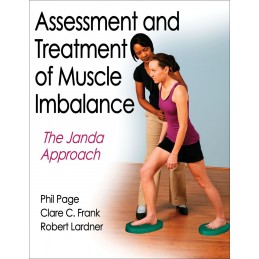- Reduced price

Order to parcel locker

easy pay


 Delivery policy
Delivery policy
Choose Paczkomat Inpost, Orlen Paczka, DHL, DPD or Poczta Polska. Click for more details
 Security policy
Security policy
Pay with a quick bank transfer, payment card or cash on delivery. Click for more details
 Return policy
Return policy
If you are a consumer, you can return the goods within 14 days. Click for more details
Assessment and Treatment of Muscle Imbalance:: The Janda Approach blends postural techniques, neurology, and functional capabilities in order to alleviate chronic musculoskeletal pain and promote greater functionality. Developed by Vladimir Janda, respected neurologist and physiotherapist , the Janda approach presents a unique perspective to rehabilitation. In contrast to a more traditional structural view, the Janda approach is functional—emphasizing the importance of the sensorimotor system in controlling movement and chronic musculoskeletal pain syndromes from sports and general activities. Assessment and Treatment of Muscle Imbalance:: The Janda Approach is the only text to offer practical, evidence-based application of Janda’s theories.
Filled with illustrations, photos, and step-by-step instructions, Assessment and Treatment of Muscle Imbalance uses a systematic approach in presenting information that can be used in tandem with other clinical techniques. This resource for practitioners features the following tools::
--A rationale for rehabilitation of the musculoskeletal sytem based on the relationship between the central nervous system and the motor system --A systematic method for the functional examination of the muscular system --Treatment processes focusing on the triad of normalization of peripheral structures, restoration of muscle balance, and facilitation of afferent systems and sensorimotor training --The role of muscle imbalance and functional pathology of sensorimotor systems for specific pain complaints, including cervical pain syndrome, upper- and lower-extremity pain syndromes, and low back pain syndromes
Assessment and Treatment of Muscle Imbalance provides an evidence-based explanation of muscle imbalance. The step-by-step Janda system of evaluation is explained—including analysis of posture, balance, and gait; evaluation of movement patterns; testing of muscle length; and assessment of the soft tissue. The text explores treatment options for muscle imbalance through facilitation and inhibition techniques and sensorimotor training to restore neuromsucular function. It also includes four case studies examining musculoskeletal conditions and showing how the Janda approach compares with other treatments. This text combines theory, evidence, and applications to assist clinicians in implementing the Janda approach into their practice.
Assessment and Treatment of Muscle Imbalance:: The Janda Approach focuses on the neurological aspects of muscle imbalance that are common causes of pain and dysfunction in sports and occupational activities. By distilling the scientific works of Vladimir Janda into a practical, systematic approach, this unique resource will assist health care providers in treating patients with musculoskeletal complaints as well as exercise professionals in developing appropriate exercise prescription and training programs.
Data sheet
Part I. The Scientific Basis of Muscle Imbalance
Chapter 1. Structural and Functional Approaches to Muscle Imbalance
Intrinsic Versus Extrinsic Fuction
Muscle Balance in Function and Pathology
Muscle Imbalance Paradigms
Summary
Chapter 2. The Sensorimotor System
Sensorimotor Hardware and Software
Neuromuscular Aspects of Postural Stability and Joint Stabilization
Pathology in Proprioception
Summary
Chapter 3. Chain Reactions
Articular Chains
Muscular Chains
Neurological Chains
Summary
Chapter 4. Pathomechanics of Musculoskeletal Pain and Muscle Imbalance
Pathology of Musculoskeletal Pain
Pathomechanics of Muscular Imbalance
Causes of Muscle Tightness and Weakness
Janda’s Classification of Muscle Imbalance Patterns
Summary
Part II. Functional Evaluation of Muscle Imbalance
Chapter 5. Posture, Balance, and Gait Analysis
Muscle Analysis of Standing Posture
Evaluation of Balance
Evaluation of Gait
Summary
Chapter 6. Evaluation of Movement Patterns
Janda’s Basic Movement Patterns
Additional Movement Tests Complementary to Janda’s Tests
Selected Manual Muscle Tests
Summary
Chapter 7. Muscle Length Testing
Muscle Length Assessment Technique
Lower-Quarter Muscles
Upper-Quarter Muscles
Hypermobility
Summary
Chapter 8. Soft-Tissue Assessment
Characteristics of Trigger Points
Assessment of Trigger Point or Tender Point Chains
Scars
Myofascia
Summary
Part III. Treatment of Muscle Imbalance Syndromes
Chapter 9. Normalization of Peripheral Structures
Central Indirect techniques
Local Direct techniques
Summary
Chapter 10. Restoration of Muscle Balance
Factors Contributing to Muscle Weakness
Additional Treatment Techniques for Muscle Weakness
Factors Contributing to Muscle Tightness
Additional Treatment Techniques for Muscle Tightness
Summary
Chapter 11. Sensorimotor Training
Role of Sensorimotor Training in Janda’s Treatment
Sensorimotor Training Components
Sensorimotor Training Progression
Summary
Part IV. Clinical Syndromes
Chapter 12. Cervical Pain Syndromes
Regional Considerations
Common Pathologies
Case Study
Summary
Chapter 13. Upper-Extremity Pain Syndromes
Regional Considerations
Assessment
Common Pathologies
Case Study
Summary
Chapter 14. Lumbar Pain Syndromes
Regional Considerations
Common Pathologies
Sacroiliac Dysfunction
Assessment
Management of Low Back Pain Syndromes
Case Study
Conclusion
Summary
Chapter 15. Lower-Extremity Pain Syndromes
Regional Considerations
Assessment
Common Pathologies
Case Study
Summary
Reference: 88633
Author: Nicole Pecora
